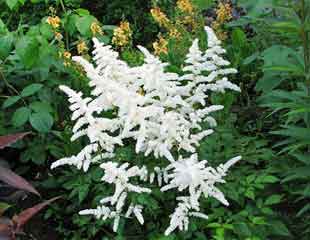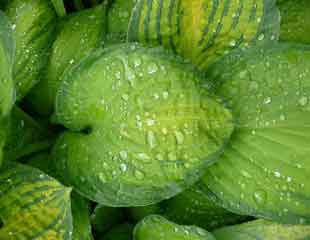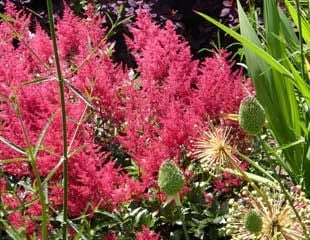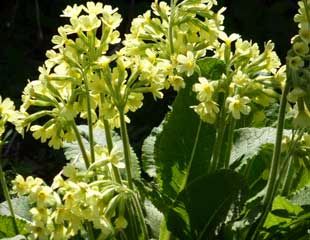Plants for Shade
Shady areas present a challenge. Books, magazines and TV all make it look so easy, when in reality getting plants to grow in the shade is more difficult and there are fewer to choose from. The saying "the right plant in the right place" comes true, especially when planting in a shady area.
The plants on this page, and the various links, are all plants that either prefer shade or will adapt to growing in it. In addition, specialist growers have bred varieties of roses and clematis to thrive in partial shade, which are not specifically listed here, but are worth checking out on their websites. I have successfully grown a lemon coloured rose in a shady area, which was purchased from David Austin Roses, and specifically recommended for growing in shade, which it did.
Illustrated below is a good range of plants that will grow well in the shade. If you are looking for more ideas, check out
Plants tolerant of dense shade tend to be foliage plants. There are varieties of Hosta which are very shade tolerant. Many ferns will grow in shade and will also tolerate dry shade, which can be hard to accommodate.
Epimedium, a spring flowering low growing ground cover plant, is happy in full shade, as is Convallaria majalis, Lily of the Valley.
When planting in a dry area, the selected plants will need more than the average watering to get established.
If the dry shade is created by deciduous trees, many of the spring bulbs will grow well before the leaf canopy forms in late spring.
Good plants for General Shady areas
Alchemilla mollis, tiny flowers make a frothy lime green plant tolerant of partial to full shade. Easy to grow, Alchemilla's only drawback is extensive self seeding.
Clematis montana is a Clematis favourite and early flowering. C. montana is vigorous and tolerant of partial shade. The lovely variety illustrated is 'Elizabeth' with the benefit of vanilla scented flowers.
This combination lifts a shady corner: Euonymus makes a bright splash of colour in light shade areas teamed with Aquilegia and yellow scented Rhododendron luteum
Snowdrops are another woodland plant and suitable for in partial shade. They are also suitable for planting under trees and shrubs. Once established, trouble free.
Really tough conditions such as dry shade need tough plants and a combination ofcommon Ivy and Cotoneaster horizontalis can make a bright wildlife friendly combination.
Astilbe has lovely feathery flowers in soft shades of pink, red white and flowers in mid to late summer. Easy to grow and shade tolerant, but only in moisture retentive soil.
Hellebores will grow in dappled shade, some in sun and some in deeper shade. Its important to check out the variety to suit your growing conditions but they are easy to grow, and self seeders.
Primula will grow well in partial shade but only in soil which is moisture retentive, they will struggle in dry shade. Primula look particularly good planted around shrubs and streams. This is the humble cowslip, our native Primula veris.

Ferns grow well in shade, both in dry and damp areas. Ferns look especially attractive in early spring as the fronds unfurl and also grouped together, as illustrated, these are shuttlecock ferns.
Japanese anemone

Japanese anemone is a late summer flowering herbaceous perennial. The grow and flower well in shade and have large attractive saucer-shaped flowers.Easy to grow, reaching around 75cms and despite being tall they do not need staking.
The only problem is that they are vigorous and for many smaller gardens, too vigorous. They will quickly colonise an area and grow and grow. Ideal if you have a large shady area.
Digitalis common foxglove

Digitalis, our common foxglove, is happy growing in shade, including dry shade. It is a self seeding biennial which is easy to grow and a UK native.
As a biennial, it will germinate and grow one year, flower and set seed the next. It is a continuous cycle masking the fact it is a biennial. All parts of the plant are poisonous.
A Shade-loving plant which is a magnet for bees and pollinators
Many bee friendly plants need to be grown in full sun but Persicaria amplexicaulis is an exception, preferring damp soil and semi-shade.
Honey bees are all over this Persicaria, as the short video shows. If you are planting into damp soil, pond margins or a bog garden and want to attract pollinators, take a look at Persicaria.











